The 20 Best Detective Movies of All Time
From a pop culture perspective, private detectives stand for all that’s memorable about film noir. The indifference, the wittiness, and the moral ambiguity that define each urban knight has since become the stuff of parodied legend. We’re talking about the mediators between the crooks and the cops, the embodiment of back alley grayness that’s so tough to pin down. P.I.’s could cooperate with the law if needed, but they could just as soon do business with the bad guys for the right price. To a certain extent, that is – shamus work has always attracted the ignored and the ethical. The Wild West has mythical men with no name, The Asphalt Jungle has names with investigating licenses attached to them. Instead of a poncho and a ten gallon hat, they’re provided a fedora and trench coat.
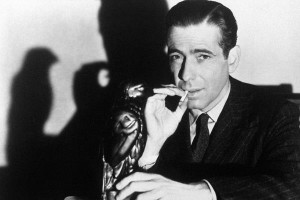
And despite noir’s mutation over the years, private eyes have remained at the forefront of crime cinema. Be it the classy guys of the 1940s or the reinvented eccentrics of the 1970s, each decade has staked its claim with an investigator that captures the generational zeitgeist. Musicals and cowboys have fallen by the wayside in the new millennium, but detectives still capture the imagination of modern audiences. Maybe it’s because we all wish we were smooth enough to fast talk a perp or solve a case; either way, few words sound cooler onscreen than “I’m a private investigator.”
Below is a list of the 20 best detective movies of all time. The list spans shamus work from 1941 to today, while excluding fan favorites who aren’t technically real investigators (sorry, The Big Lebowski). And while there’s a soft spot for the guys of golden age noir (1941-1958), modern iterations definitely give these classics a run for their money. Time to light ‘em if you got ‘em, the shadowy selections are now underway.
20. Tony Rome (1967)

Released in the wake of the 1960s detective craze, Tony Rome syncs up nicely with lightweight peers like P.J. (1968) and Marlowe (1969), though it outclasses the competition through undeniable glamour. Rome is to film noir what Ocean’s 11 (1960) is to heist films: a lavish production and a fun way to kill an hour and a half. The same goes for Tony’s 1968 sequel Lady in Cement.
19. The Girl Hunters (1963)
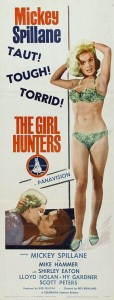
The mind-bending context takes some getting used to, yet even without this bizarre gimmick, the film remains a hard-nosed delight. Spillane makes up for his shortcomings as an actor with a gut feeling approach that fits the character like a torn glove, and few guys could rattle off (his own) dialogue with such ferocity. It’s cheap, crass, and chock-full of inexpensive excitement, the kind of conditions that only a guy like Mike could thrive under. Spillane wanted to make a sequel based on his novel The Snake, but the damn thing didn’t make enough money to justify a follow-up. Too bad.
18. Night Moves (1975)
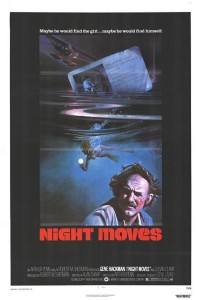
Directed by Arthur Penn at the tail end of his creative heights, Moves finds former quarterback Harry Moseby (Gene Hackman) trapped in a case that ultimately provides more questions than answers. Hackman, fresh off of embodying paranoia in The Conversation (1974), is a lost cause in a sea of corruption. Granted, most detectives are, but that trait rings particularly true here. Night Moves sticks out for its refusal to follow the tidy detective formula; it may annoy some, but it will enthrall those who seek out something unique. It’s also fun to see future stars Melanie Griffith and James Woods in their film debuts.
17. Devil in a Blue Dress (1995)

Segregation was alive and well in 1948, and the notion of integration festered at both the underbelly and the upper class of America. As if a detective’s job wasn’t already tough enough. Washington is a pillar of charisma as “Easy,” a perfect mesh of actor and character that permeates the film with a crucial flavor of integrity. The find-the-fatale plot is nothing new, but Franklin’s classy period direction offers up a generous helping of Hollywood glamour. Unfortunately, Blue Dress was another example of squandered sequels, as lackluster box office numbers kept “Easy” from returning in subsequent cases.
16. The Missing Person (2009)

No doubt aided by its similarly minuscule budget, the case impressively translates the post trauma of WWII to a generation of 9/11 survivors – a topic rarely incorporated into modern crime drama. Michael Shannon and co-star Amy Ryan are an unconventional match made in indie heaven; their distinct looks and colorful personas intermingling like primary shades. Shannon, in particular, sells the disgruntled shamus with scene-stealing personality to spare. As one of the lesser known inclusions on the list, The Missing Person brings an old school nostalgia to new school dilemmas.
15. I Love Trouble (1948)
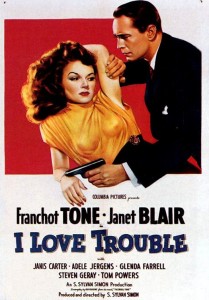
No edgy twists or genre bending mash-ups to defy expectations, just a perfectly executed thriller that maximizes its cheap potential. Tone isn’t the most demanding presence ever put onscreen, but he’s got a walk-and-chew-gum type of charm that matches the breezy proceedings. The Chandler influence is pretty transparent on Huggins’ self-adapted script, but there’s such an undeniable charm to the author’s writing that he’d end up making a Hollywood career out of it – going on to write for iconic detective shows like 77 Sunset Strip and The Rockford Files. Not bad for a Marlowe hack.
14. Dead Again (1991)
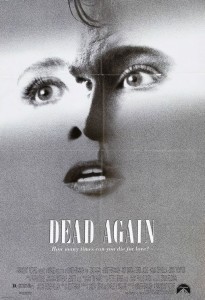
Director Kenneth Branagh stars as Mike Church, detective un-extraordinaire, who’s called upon to investigate the mental state of the enigmatic Grace (Emma Thompson). Church slowly breaks the mystery woman’s nonverbal facade, but memories of a murderous husband begin blurring the lines between past and present. Suddenly, Mike doesn’t know the difference either.
Dead Again was a moderate success upon initial release, but it’s somehow avoided the cult following that’s becoming more and more common in the internet age. A romantic neo-noir with a supporting cast of Andy Garcia, Wayne Knight, and Robin Williams?! It reads like a fever dream elevator pitch, but it plays out like a well-oiled hybrid of Hollywood magic.
13. Brick (2005)

Hammett is sprinkled all over this thing; dialogue, images, and situations are directly pulled from seminal novels like Red Harvest and The Maltese Falcon, with particular emphasis on the former. The Continental Op provided enormous influence for rookie screenwriter Johnson, who referred to Brendan as an adolescent take on the iconic investigator onset. Marketed with the subtitle “a detective movie,” Brick’s gimmicky high school environment masks a deep seated respect for the legends of yesteryear. Who says kids can’t respect their elders?
12. 8 Million Ways to Die (1986)

As for why it’s remained critical stomping ground remains a mystery – this thing is a rip roaring detective classic for the glitzy 1980s. Bridges sells the character’s flawed nature much more than Neeson, who always seemed a little too put together to be a drunk. Combined with a surprisingly actioned packed script and a shoot-out finale that remains iconic to all who’ve seen it, 8 Million Ways to Die is in dire need of a cinematic re-evaluation.
11. Kiss Kiss Bang Bang (2005)
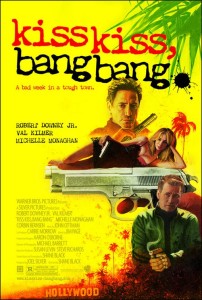
Kiss Kiss also represents the only detecting duo to make the list, and what a hell of a duo it is. First off there’s Harry Lockhart (Robert Downey, Jr.), a thief masquerading as an actor who’s masquerading as a detective. It’s too complicated to explain why or how. And as his senior partner/voice of reason, there’s “Gay” Perry Van Shrike (Val Kilmer), a Hollywood P.I. who’s seen way more than we’d care to know.
Trying to decipher the plot would take longer than watching the actual movie. Black, a screenwriting legend who continuously reinvents the buddy genre with films like Lethal Weapon (1987), The Last Boy Scout (1991), and The Long Kiss Goodnight (1996), really outdoes himself with this one, as witty one liners and pop culture tie-ins are thrown so quickly at the viewer that they’d make Quentin Tarantino spin in his chair. And from the sounds of it, this year’s detective thriller The Nice Guys looks to add another classic to that list.
10. Harper (1966)
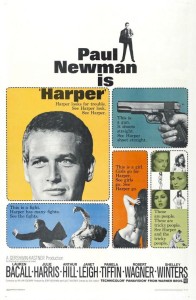
Archer, eventually altered to Harper for the film adaptation, was a self-described “new type” of detective; and that claim proved true in more ways than one, as Paul Newman’s playful performance exemplified. No longer the sweet talking Marlowe or the gruff Mike Hammer, Harper uses coy mind games and manipulations to get the info he needs. Aloofness is a great asset in the right situation, and Newman’s blue-eyed goofball is a sober departure from his forefathers.
The film was a huge success in 1966, making it one of the few detective pictures to pick up a sequel with 1975’s The Drowning Pool. But Pool lacked the stylish fun of it’s original, making one ponder how great a follow-up could’ve been if released sooner than a decade apart. Either way, both Harper and Macdonald are primed for some retrospective adoration. And with the announcement of Joel and Ethan Coen’s adaptation of the novel Black Money, it sounds like Macdonald will get it sooner rather than later.
9. 8mm (1999)

The film stars a top-notch Nicolas Cage as Tom Welles, private investigator for the ritzy crowds. He’s also a family man who initially balks at the proposition of tracking down a dead millionaire’s “snuff film.” Welles naturally takes the case for the right price, but what he finds along his jet black journey is a porn world of unspeakable horrors – Tom won’t be bouncing back from this one anytime soon.
8mm earns its stripes as one of the most unrelentingly dark thrillers on the list. Schumacher dials down every glamorous instinct he has to a crawl, and the results are breathtakingly morbid. The film was universally shrugged off in 1999, and has since been tucked away in the careers of both Schumacher and Cage; but while it may consist of back alley content, this unsung masterpiece deserves to sit front and center.
8. Angel Heart (1987)
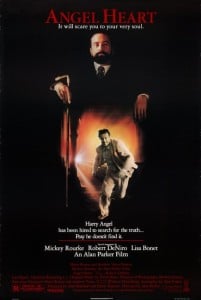
Parker pulls a surprise twist for the ages with this one, but not before subjecting the viewer to one of the great psychological mysteries of its time. In a case that leads from Brooklyn to the Bayous of New Orleans, Harry’s descent into Satanic Rituals and Voodoo are far from the urban deception of the old school guys. In the middle of it all is Rourke’s earnest investigator, a good guy who seems destined to catch only bad breaks on his way to facing the ultimate evil.
Angel Heart isn’t a noir for the faint at heart. It prods and shocks even thirty years after its release, but this taboo tendency is also what makes it so integral to the detective genre. By subjecting its protagonist to the darkest corners of madness, the film tore a daring new path for P.I. possibilities.
7. Inherent Vice (2014)
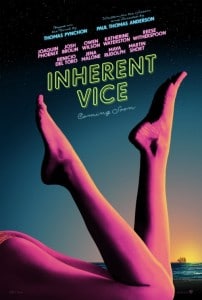
Larry “Doc” Sportello (Joaquin Phoenix) isn’t a suit-and-tie kind of guy. He’s more of a flip flops and mutton-chops dude, content with a lazy P.I. practice and a worn-down joint. “Doc” gets involved in a missing persons case at the behest of his former flame, but by no means is he prepared for the fiery revolving door of characters that tumble through his physician’s office. Phoenix hilariously captures the bewildered buzz that Sportello operates under daily, tapping into a facial performance that says far more than any stoner babble ever could.
It helps that he spends most of his time listening to a cast (Josh Brolin, Reese Witherspoon, Benicio del Toro, Owen Wilson) with enough charisma to fill a dozen films, but never is he lost in the shuffle of sunny dispositions. Inherent Vice is the movie equivalent of a kaleidoscope; aimless colors coming together to create a beautifully rendered image. Anderson really outdid himself on this one. Noir finally joined forces with psychedelia – and the results are trippy, man.
6. The Long Goodbye (1973)

Jokingly referred to as “Rip Van Marlowe” on the set, Altman’s vision was to drop a man with 1953 morals into the hippie-filled hills of the 1970s. And as the famous detective, Gould brings this unique take to life through jaunty small talk and a permanent wince. Whether rubbing ink on his face or getting outsmarted by his cat, the days of sweet talker Marlowe are long gone. Consequently, The Long Goodbye was a critical and commercial dud in 1973 – too traditional for the young crowd and too artsy for the old crowd. But its reputation has grown exponentially in the decades since, opening a lane for unconventional noir that would inspire several of the guys who’ve already made the list. For Altman fans, this remains the unsung gem in his one-of-a-kind résumé.
5. The Big Sleep (1946)
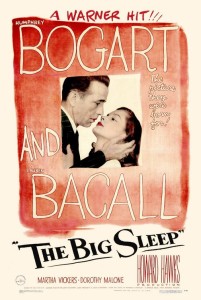
This time, Philip Marlowe (Bogart) is hired by an aging millionaire to nab a blackmailer currently extorting his daughter. And of course, a tug at this thread eventually undoes an entire collection of cover ups and deaths along the California coast. Bogie is in top form here, sharpening the nuances that made his Sam Spade so iconic and adhering them to a slicker movie world. Every other line he rattles off is a verbal gem, especially when going head-to-head with the millionaire’s other daughter Vivian (Bacall). We know they’ll end up together, but it doesn’t make the journey any less entertaining to watch.
The Big Sleep is so incredibly well assembled that harping on its plot holes seems a bit extraneous. Hawks masterfully spins his screwball chops and keeps the chattiness entertaining, while his star inhabits the famous detective effortlessly. It’s tough to peg whether Bogart is playing Bogart or Marlowe – but whatever’s being played, it’s impossible to take your eyes off of the screen.
4. Kiss Me Deadly (1955)
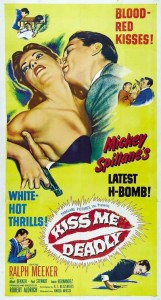
To be fair, it’s understandable why Spillane despised this version so strongly. Screenwriter A.I. Bezzerides hated the Hammer stories and saw them as nothing more than a glorified comic strip – an ideology he enhanced in his adaptation. Several changes were made to the famous detective, from his Los Angeles relocation to a sudden penchant for vanity that made him even less likable. But in the grander scheme of director Robert Aldrich’s exaggerated world, it flowed like blood into a city gutter.
Hammer pulverizes his way through a baroque assortment of low life scum, eventually arriving at the intersection of film noir and science fiction. The “greatwhatzit” of the finale has since become the stuff of pop culture legend, appearing time after time in movies like Repo Men (1984) and Pulp Fiction (1994). By pushing the genre to its stylistic limits, Kiss Me Deadly became the punk movement to The Maltese Falcon’s rock and roll. Pandora’s film noir box had now been opened.
3. Murder, My Sweet (1944)

Murder, My Sweet is an incredible film. Encompassing every detective trick in the book (Chandler’s book), Murder balances narration, femme fatales, and a flawlessly executed visual style with ease. The shadows and angles that permeate the private eye’s stubbled snooping are matched only by Dmytryk’s career defining direction, while Powell’s shrug off acting style captures the literary character like a Polaroid snapshot – a sort of reverse approach to Kiss Me Deadly’s Mike Hammer.
Perhaps more than any other film on the list, Murder, My Sweet plays out in traditional noir fashion. No tricks, twists, nor turns; just a note-for-note adaptation of Chandler’s Farewell, My Lovely. The film title was altered shortly before release due to Powell’s reputation, fearing everyone was going to walk in expecting a musical. But whatever name by which you call it, this film is a shadowy pillar of perfection.
2. Chinatown (1974)
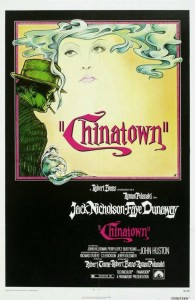
The ending of the picture is a mesmerizing surprise to those who’ve never seen it, and a reminder of Roman Polanski’s embittered genius to those who have. As the one time in which the director fought Towne on a plot point, the finale adds an existentialism that reconfigures the entire piece. Maybe failure is inherent to all detectives. Maybe the idea of good triumphing over evil is reserved only for Hollywood. It’s probably best to just forget it. This is Chinatown after all. Not just a private eye classic, but one of the greatest American films ever made.
1. The Maltese Falcon (1941)

The storyline has become so ingrained in the culture’s DNA that people get Falcon references without having even heard of the film. Each fedora sporting spoof or ironic noir commentary comes at the expense of Spade’s quest for the black bird, a testament to Bogart’s unforgettable acting. In the role that made him a star, Bogie runs the gamut on manipulations and deceit, outsmarting an array of professional liars in his path.
Rookie director John Huston, who would appear thirty-three years later as the villain in Chinatown, helms one of the greatest debuts ever put to celluloid. Concise and stylish, his work behind the camera brought mystery thrillers out of the drawing rooms of the 1930s and into the modern age of film noir. Its four Academy Award nominations (including Best Picture) spoke volumes for the tonal shift of Hollywood in the 1940s – noir was now viable as a commercial template. And it remains viable to this day, all thanks to “the stuff that dreams are made of.” We tip our fedoras to you Sam Spade. You’re not a good man, but you’ve done plenty of good.



Latest posts by Danilo Castro (see all)
- The 20 Best Detective Movies of All Time - February 16, 2016
- Life & Death: Ranking the Films of Alejandro González Iñárritu - January 6, 2016
- Evolution of a Champ: The Rocky Film Saga - November 25, 2015


